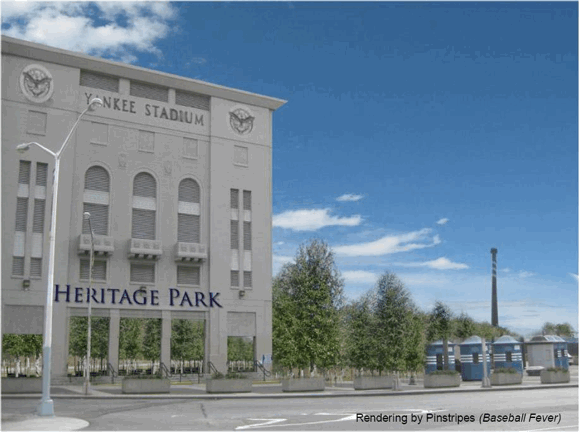
Despite efforts, Heritage Park will not incorporate much of old Yankee Stadium. (Image via Save the Yankee Gate 2)
New York City is one of the oldest towns in the nation. Founded by the Dutch in 1624, it was the capital of the nation for five years and has been the country’s biggest city since 1790. Despite this legacy, though, the city is shockingly lacking in history.
Stroll around Lower Manhattan, some of the longest continuously settled lands in North America, and the history is from the late 1800s and not the mid-1700s. Instead of historic preservation mixed in with modern development, New York City has continually built over and on top of its history.
More immediately, our city’s ballpark history is marked with gone and nearly forgotten stadiums. All that remains of Ebbets Field is a housing project in Flatbush. The Polo Grounds is also a housing project, and Shea Stadium, no one’s favorite place to watch a game, is a parking lot.
Across the street from the current Yankee Stadium sits the old House that Ruth Built, an 85-year-old Baseball Cathedral. Sure, it was gut-renovated in the 1970s, and many old-time fans feel it lost its character then. But the truth remains that Yankee Stadium after the renovation saw its fair share of historic games.
When the Yankees announced plans to build a new home, the old stadium was to be turned into a park called Heritage Field. Supposedly, this new field would incorporate Yankee baseball history and serve as a living monument to the stadium. Now, though, as details about the city’s plans for the park come into view, little of Yankee Stadium will remain, and the park may serve more as a monument to what could have and should have been than to what was.
In the current issue of The New Yorker, Paul Goldberger penned a Talk of the Town piece on the future of Heritage Field. The Parks Department and the Yankees convened a summit to discuss ways to incorporate the stadium, but the outcome was less than appealing:
Now that the Yankees have moved to their new $1.5-billion ballpark, the question has arisen as to whether their former home ought to disappear as completely as Shea did. The city has promised to turn the site into a park, complete with three ball fields. But the current design calls for the entire stadium to be demolished, its history recalled mainly through a series of panels and plaques in the pavement…
[Park designer Gary Sorge] explained that one of the three ball fields would be set in roughly the position of the old Yankee Stadium diamond, but shifted slightly, so that second base would be atop the original home plate. The plans also called for the reuse of two thirty-foot-long panels of the old Stadium’s famous scalloped frieze. And the designers proposed painting two of the park’s field light posts to resemble foul poles.
[Bronx borough historian Lloyd] Ultan, the historian, was the first to respond. “What is missing from the design is the architecture of the Stadium itself,” he said, holding up a souvenir cookie tin shaped like the old Stadium. “Some people came to see me recently who were trying to save Gate 2, which has not been altered. Couldn’t we preserve that as a monument?”
“Our research showed that Gate 2 had been altered,” one of the planners said. “It would have to be restored.”
So then restore it, I say.
Later on during the meeting, Sherida Paulsen, a former head of the city’s Landmarks Preservation Committee, posed a good question. “Putting second base at home plate doesn’t make sense,” she said. “Why can’t home plate just be at home plate?”
In the end, the city should do more than create a park that sort of resembles Yankee Stadium while telling a story through staid plaques and panels in the pavement. They should be able to create a monument to a great ballpark while keeping the essence of the park alive. It is a challenge in urban planning, but after decades of tearing down history, it is one the city should meet.
Parks Department head Adrian Benepe would seem to agree. “Yankee Stadium has had papal Masses, Billy Graham’s crusade, championship boxing matches, and the rally when Nelson Mandela was freed,” Benepe said. “Why can’t we create a great new park that acknowledges all of this?”
Why can’t we, indeed.
Leave a Reply
You must be logged in to post a comment.